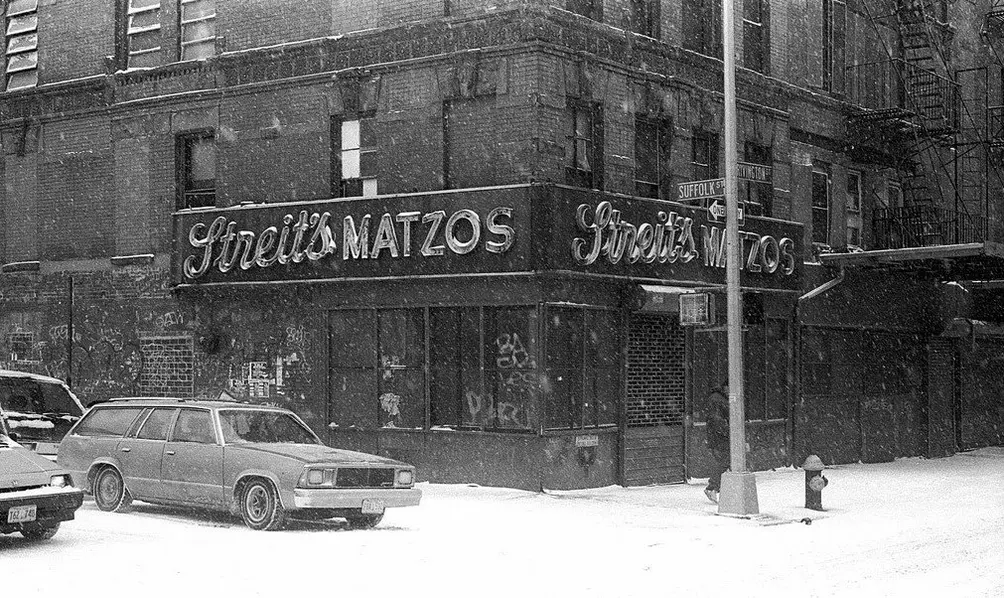In 1925, the Streit family opened The Streit's Matzo Factory at 150 Rivington Street, expanding eventually to the three adjoining buildings. Over the years, it became a fixture on the Lower East Side. Flash forward 90 years when operating there became untenable. Despite all their efforts, the family realized that in order to move forward, they would have to move their factory to more modern digs, and they sold the property to Cogswell Lee Development in 2015.
Arthur Stern has served as CEO of Cogswell Realty since it was founded in 1996. In 2014, Cogswell formed a new acquisition arm, Cogswell Lee Development with Lee & Associates. Together, they've reimagined the property at 150 Rivington into 45 one- to three-bedroom luxury residences housed in a modern building that reflects the surrounding architecture. This is the first of two interviews with the developer Arthur Stern and architect Charlie Kaplan of Gluck+ Architects, the firm responsible for the new design.
Arthur Stern has served as CEO of Cogswell Realty since it was founded in 1996. In 2014, Cogswell formed a new acquisition arm, Cogswell Lee Development with Lee & Associates. Together, they've reimagined the property at 150 Rivington into 45 one- to three-bedroom luxury residences housed in a modern building that reflects the surrounding architecture. This is the first of two interviews with the developer Arthur Stern and architect Charlie Kaplan of Gluck+ Architects, the firm responsible for the new design.
 Image by Leo London/Flickr
Image by Leo London/Flickr
In this article:
Did you buy Streit’s Matzo Factory intending to demolish it, or did you ever think about using the existing structure?
Arthur Stern: Our first inclination was to adapt what was there, recognizing the historical significance of the site. The reality was that Streit had combined four tenements back in the 1920s they had purchased over a period of ten years, and those four tenements were of uneven heights. They had eight-foot ceilings, structural columns that didn’t match up, and it would have been physically improbable to convert those.
Our first inclination was to adapt what was there, recognizing the historical significance of the site... [But there were] eight-foot ceilings, structural columns that didn’t match up, and it would have been physically improbable to convert those.
The family had been wrestling with the issue for decades, and they desperately wanted to stay. They obviously had a strong historical connection to the site, but they couldn’t figure out a way that they could modernize the factory and equipment. Because of the nature of the four interconnected buildings and the way they were set up, there was no way it could be done for them, or for us. The fact that there’s a residential building now available is a natural evolution of that neighborhood. So we had a blessing ceremony on the roof where we had a consultant perform a Feng Shui ceremony along with the rabbi who worked at the factory for decades.
What was your intent in organizing the ceremony with Feng Shui architect R. D. Chin?
Arthur Stern: From the beginning, we felt that we should bring in a consultant. R. D. Chin is a Harvard educated, internationally recognized Feng Shui consultant. We wanted to bring him in not solely because we believe in the principles of Feng Shui, but because we felt that the holistic approach to development—and getting his opinion on how design should interact with nature—was important. So we had him as a consultant side-by-side with Charlie Kaplan and Gluck+. The ceremony was about believing in the principles of Feng Shui and Chi energy before you start construction, and we felt strongly that in connection with that we should also have the rabbi who worked on the site be with us because of his historical connection to the site. So on the roof, the two of them performed a ceremony that was attended by family and friends. It was unique, and it was fun, and we felt that it set the right tone for redeveloping this historic site. They gave us the mezuzah that was hanging on the door of the factory for 90 years that we’re going to put in the new building.
The new building resembles the old building in the shape of its outline. What are your aspirations for what’s going on in the neighborhood in terms of the real estate?
Arthur Stern: I do think that the people who are moving there appreciate distinctive architecture and quality. In that respect, it’s very much like Chelsea where people appreciate architecture that’s different. The type of apartments we designed reflects the type of people that are buying down there, and the form mimics the type of architecture that’s down there. It’s the same type of geometry. It’s not out of place, and that was the goal, to try to create a modern interpretation of what historically has been there.
It’s not out of place, and that was the goal, to try to create a modern interpretation of what historically has been there.
What was the response from the community, especially after the film, “Streit’s: Matzo and the American Dream,” premiered at the Film Forum?
Arthur Stern: The family that owned it was very close. From their perspective, and they made it pretty clear, there was no way that they could operate the matzo factory on the Lower East Side. It had nothing to do with gentrification, and it had nothing to do with cost. It was because of the nature of the infrastructure involved, the equipment they had, and getting delivery trucks in and out of the Lower East Side. So they couldn’t continue in business there. I don’t think anyone had any malice towards us. It was more nostalgia for the Lower East Side. It clearly wasn’t an example of someone who buys the site and forces them out. They made a decision a long time ago that they couldn’t operate there. People understood the reality. The family couldn’t exist here, so they are going to build a better factory up in Rockland. It’s more efficient, and they took all their workers with them. They’re going to set up something for the next 90 years.
We don’t have the ability, nor would people want to change the character of the neighborhood. There will be some sites that are built up, and there will be sporadic development, but it’s not going to be a wholesale change when the basic character of a neighborhood changes. The nature of the retail obviously is going to change, the peddlers and everything else. But they’re still going to be some grit in the neighborhood. Yes, it’s different, rents are among the highest, but there are still some buildings that will remain. Because of the nature of the buildings, the character of the area is largely going to remain intact.
Would you like to tour any of these properties?

Contributing Writer
Jillian Blume
Jillian Blume is a New York City based writer who has published articles widely in magazines, newspapers, and online. Publications include the New York Observer, Marie Claire, Self, MSN Living, Ocean Home, and Ladies Home Journal. Jillian received a master's degree in Creative Writing from New York University and teaches writing, critical reading, and literature at Berkeley College.


 6sqft delivers the latest on real estate, architecture, and design, straight from New York City.
6sqft delivers the latest on real estate, architecture, and design, straight from New York City.
